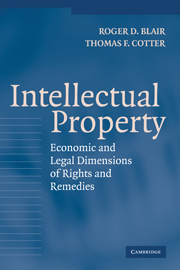Book contents
- Frontmatter
- Contents
- Acknowledgments
- 1 Introduction
- 2 The Law and Economics of IPRs
- 3 A General Theory of Damages Rules
- 4 Departures from the General Theory
- 5 Liability Standards for IPRs
- 6 Who Is an Infringer?
- 7 Who Should Be Entitled to Sue for Infringement?
- 8 Calculating Monetary Damages
- 9 Concluding Remarks
- Bibliography
- Index
7 - Who Should Be Entitled to Sue for Infringement?
Published online by Cambridge University Press: 08 January 2010
- Frontmatter
- Contents
- Acknowledgments
- 1 Introduction
- 2 The Law and Economics of IPRs
- 3 A General Theory of Damages Rules
- 4 Departures from the General Theory
- 5 Liability Standards for IPRs
- 6 Who Is an Infringer?
- 7 Who Should Be Entitled to Sue for Infringement?
- 8 Calculating Monetary Damages
- 9 Concluding Remarks
- Bibliography
- Index
Summary
In this chapter, we examine in some detail the question of standing and joinder – that is, of who is entitled to sue for patent, copyright, or trademark infringement. This question, which is the flipside of the question we examined in the last chapter (who gets sued?), could be answered in a variety of ways, each of which could affect the originator's expected payoff and hence its ex ante incentives to create, publish, innovate, and invest in quality control. Although the answer might seem obvious – the owner of the IPR has the right to sue – a moment's reflection suffices to reveal that the question is more complicated. Is an assignor with some sort of ongoing interest in the IPR an “owner”? Does a licensee have a sufficient interest to file suit? If so, must the licensor join the suit? Should all licensees have the same rights or should they vary depending upon one's status as an exclusive or nonexclusive licensee? What exactly does it mean to be an exclusive licensee?
A simple – albeit somewhat fanciful – example may help to illustrate these issues. Suppose that a modern-day Dr. Frankenstein applies for a U.S. patent on his process for reanimating a dead body, as well as on the computer software he has used to implement the invention; that he registers his copyright on the software with the U.S. Copyright Office; and that he assigns his patents and copyrights to a corporate entity, Reanimators S.A. Reanimators in turn licenses an American company, Karloff, to provide reanimation services in the United States using Frankenstein's patented inventions and copyrighted software under his now-famous trademark, FRANKENSTEIN.
- Type
- Chapter
- Information
- Intellectual PropertyEconomic and Legal Dimensions of Rights and Remedies, pp. 160 - 207Publisher: Cambridge University PressPrint publication year: 2005



